- Scientific name: Bolboschoenus novae-angliae (Britt.) S.G. Smith
- Synonyms: Schoenoplectus novae-angliae (Britt.) M.T. Strong, Scirpus novae-angliae Britt.
- Species of Greatest Conservation Need (MA State Wildlife Action Plan)
Description
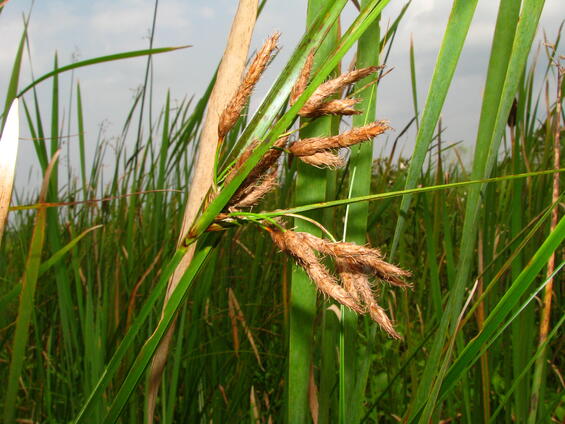
Photo credit: Kerry Wixsted
New England bulrush is a tall, robust herb in the sedge family (Cyperaceae). Bulrushes are large, grass-like plants resembling large sedges or true rushes (Juncus spp.) that typically grow in dense stands in brackish wetlands at the freshwater edge of salt marshes or tidal rivers. This is a globally rare species with a rank by NatureServe of G3 meaning that the species is vulnerable on a global scale (NatureServe 2025). G ranks go from 1 to 5 with 5 being most secure and1 is most vulnerable.
Height: New England bulrush can grow up to 1.5 m (50 in). Flowering stems are up to 1 cm (0.4 in) thick and topped by a cluster of 10–40 narrowly ovoid brown spikelets, most of which are on elongated branches. The stems have between 4 to 9 leaves up to 70 cm (27.5 in) in length and up to 13 cm (0.5 in) wide. New England bulrush spikelets are 1.5–4 cm (0.6-1.6 in) long, 5–6 mm (0.2-0.24 in) wide, and rusty-red or orange-brown in color—they may be solitary or arranged in groups of 2–7 on the branches.
Mature fruits, a technical key, microscope, and the ability to make sub-millimeter measurements may be needed for positive identification. Multiple achenes from the same plant should be examined (Dodds 2024). The plant is a close cousin of two common bulrushes in the same general wetland habitat.
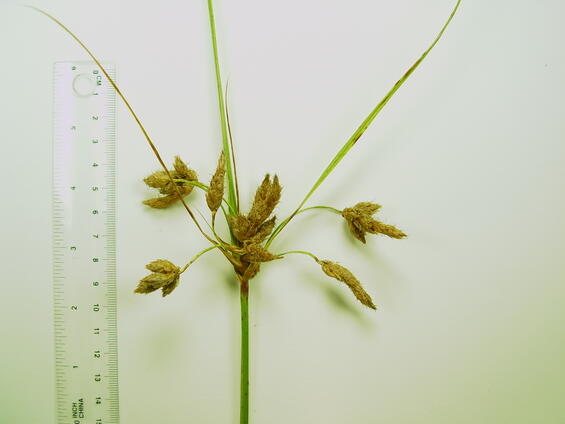
Photo credit: Don Cameron
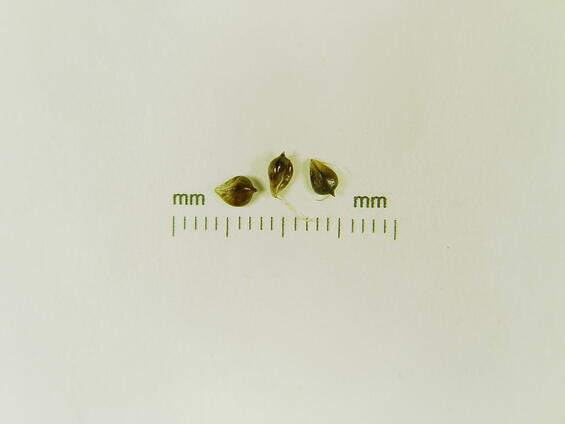
Photo credit: Don Cameron
Life cycle and behavior
New England bulrush is perennial and generally flowers every year. It is wind pollinated.
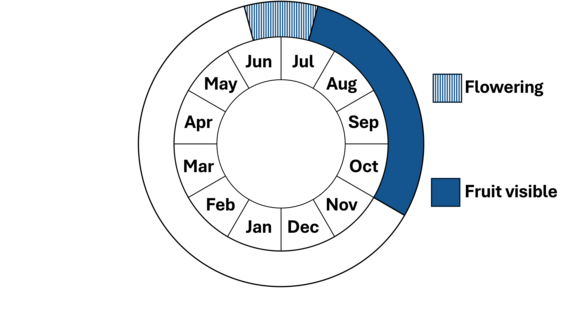
Flowers can appear in the second half of June and begin setting fruit in mid July. Fruit is visible generally all the way through October.
Population status
New England bulrush has been tracked by MassWildlife’s Natural Heritage Endangered Species Program (NHESP) as a watch-list species since 1982 and has 7 records. In Massachusetts, the plant has been found in Nantucket, Barnstable, Dukes and Plymouth counties. There are 23 herbarium specimens from Massachusetts in various herbaria in the region including one from 2021 from Nantucket (CNH 2025). iNaturalist has no observations for this species along the entire Massachusetts coast. As these tend to be long-lived perennial species with heavy root stocks, NHESP believes it does still occur in our state. Data are limited for several reasons:
- Populations may be difficult to access across private land or may require use of a boat.
- The species bears a strong resemblance to two other sister species that share the same or similar habitat and are much more common (Bolboschoenus robustus and Bolboschoenus maritimus). Many field botanists and naturalists might therefore overlook New England bulrush assuming what they are seeing is one of the more common species.
- A collection must be taken in order to be certain of the identification, requiring extra work and time. With the habitat consisting of mucky wetlands, with water up to two feet deep, special footwear is often needed to collect a specimen.
- Amateur botanists might not be capable or have the equipment necessary to make the positive identification.
Distribution
New England bulrush extends from Maine down the coast to Georgia and is considered rare in every state where it occurs (NatureServe 2025). It is considered critically imperiled in Delaware, Maine, Massachusetts, New Jersey, and New York; imperiled in Maryland, vulnerable in Connecticut and Virginia and possibly extirpated from Georgia and North Carolina.
Habitat
New England bulrush is an obligate wetland species that occurs in full sun along estuaries, brackish marshes, shores, ditches and tidally influenced rivers.
Healthy habitats are vital for supporting native wildlife and plants. Explore habitats and learn about conservation and restoration in Massachusetts.
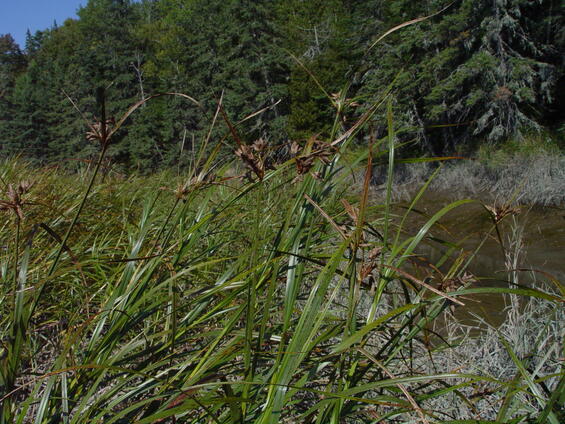
Bolboschoenus novae-angliae (New England Bulrush) showing mature fruit and habitat in Maine. Note tidal mud along a waterway on the right edge of the photo. Photo credit: Don Cameron
Threats
New England bulrush is threatened by shoreline and harbor development, coastal erosion, and sea-level rise which is expected to continue as the climate warms. In the Northeast US, sea level has risen about 30.5 cm (12 in) since the year 1900, faster than the global average rate (Staudinger et al. 2024). Since this species occupies a restrictive, narrow band in wetlands between salt water and freshwater habitats, it is at high risk to become extirpated from the state. This is also an area inhabited by a problematic invasive species. Phragmites australis (giant reed grass) can grow thickly and taller than the bulrush and so can entirely eliminate habitat where the bulrush previously occurred or might occur.
Conservation
Survey and monitoring
Given these are large perennial species, monitoring could be done on a five-year cycle in the fall with estimates of plant vigor and seed production. Special emphasis should be made to target this species which is 30 or more years overdue for survey and monitoring.
Management
Treatment, using herbicides to eliminate populations of Phragmites australis (giant reed grass) along the coast could expand available habitat for New England bulrush.
Research needs
More research is needed to determine faster methods to identify this species and its cogeners in the same habitat. For example, some keys have mentioned length of time seeds will float but this has so far not proved reliable. More work could be done on this and other factors. Research is needed to answer the question as to whether this plant can be grown in a nursery or garden setting for purposes of reintroductions. As sea-level rise may create new habitat while at the same time isolating current populations, this strategy could prove useful to long-term conservation of this species.
References
Arsenault Matt, Glen H. Mittelhauser, Don Cameron, Alison C. Dibble, Arthur Haines, Sally C. Rooney, and Jill E. Weber. 2013. Sedges of Maine: A Field Guide to Cyperaceae. University of Maine Press, Orono, ME. 712 pp.
CNH 2025 Consortium of Northeastern Herbaria web site, www.neherbaria.org, accessed 14 Feb 2025.
Dodds, Jill S. 2024. Bolboschoenus novae-angliae Rare Plant Profile. New Jersey Department of Environmental Protection, State Parks, Forests & Historic Sites, Forests & Natural Lands, Office of Natural Lands Management, New Jersey Natural Heritage Program, Trenton, NJ. 17 pp. (see https://www.nj.gov/dep/parksandforests/natural/heritage/docs/bolboschoenus-novae-angliae-new-england-bulrush.pdf)
Fernald, M. L. 1950. Gray’s Manual of Botany, Eighth (Centennial) Edition—Illustrated. American Book Company, New York.
Gleason, Henry A., and Arthur Cronquist. Manual of Vascular Plants of Northeastern United States and Adjacent Canada, Second Edition. Bronx, NY: The New York Botanical Garden, 1991.
Haines, Arthur. Flora Novae Angliae. New England Wild Flower Society, Yale University Press, New Haven, CT. 2011.
iNaturalist. Available from https://www.inaturalist.org. Accessed 14 February 2025
NatureServe. 2025. NatureServe Network Biodiversity Location Data accessed through NatureServe Explorer [web application]. NatureServe, Arlington, Virginia. Available https://explorer.natureserve.org/. Accessed: 2/14/2025
POWO (2025). "Plants of the World Online. Facilitated by the Royal Botanic Gardens, Kew. Published on the Internet; https://powo.science.kew.org/ Retrieved 10 February 2025."
Staudinger, M.D., A.V. Karmalkar, K. Terwilliger, K. Burgio, A. Lubeck, H. Higgins, T. Rice, T.L. Morelli, A. D'Amato. 2024. A regional synthesis of climate data to inform the 2025 State Wildlife Action Plans in the Northeast U.S. DOI Northeast Climate Adaptation Science Center Cooperator Report. 406 p. https://doi.org/10.21429/t352-9q86
Contact
| Date published: | March 25, 2025 |
|---|